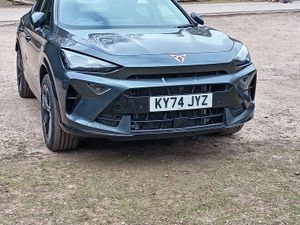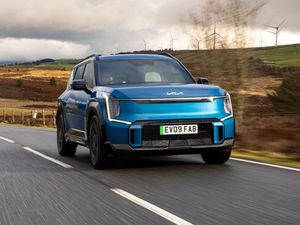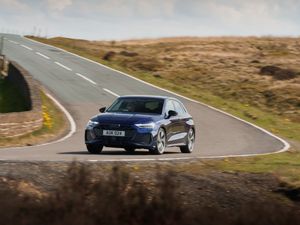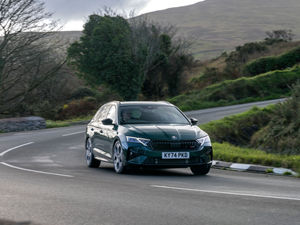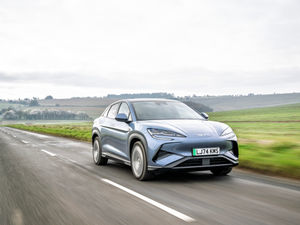UK Drive: Can the Ford Edge Vignale cut it as a luxury SUV?
Ford’s taken its flagship SUV, the Edge, and applied liberal amounts of chrome and equipment to create the new Edge Vignale. Tom Wiltshire puts it to the test to see if it can compete with more premium rivals
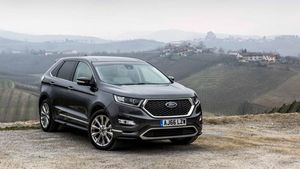
What is it?
Ford’s Vignale nameplate is a luxury sub-brand, which Ford says is a response to customer feedback. Loyal buyers of the American brand were buying more and more top-spec Titanium models, leaving them nothing higher to upgrade to when trade-in time came around.
In response, Ford’s added Vignale trim across its model line-up, which acts as a range-topping trim – giving customers extra kit, improved materials, chrome detailing, and dedicated Vignale benefits.

We’re testing Ford’s flagship SUV – the Edge – in this glitzy Vignale spec. The Edge is an American import, and sells in huge numbers across the pond, but does this kit-and-chrome-laden 4×4 appeal to UK tastes?
What’s new?
On the outside, the Edge Vignale gets a selection of exclusive paint colours. Once it’s been painted, Ford lets its design team loose with chrome detailing – there’s a massive and imposing Vignale-specific grille, glitzy chrome wheels and shiny roof rails.
Inside, the Vignale gets quilted leather seats, while Ford’s covered the plastic dashboard with swathes of leather. The carpet’s thicker, and even the boot is coated in deep-pile shag.
Under the skin not much has changed, but there’s extra soundproofing to make the Vignale a relaxed and refined cruiser.
What’s under the bonnet?
The Edge Vignale is available with just one 2.0-litre diesel, available in two states of tune. The lesser model gets 178bhp and a six-speed manual gearbox, while the top brass can choose the 207bhp version mated to a six-speed auto.

Our car was the latter. The engine is fairly refined, but it’s definitely no speed demon. Customers at this price level may be a little disappointed, especially as a similarly priced BMW X3 will complete the 0-60mph sprint in under six seconds compared to over nine for the Vignale.
The gearbox is smooth, but feels old-fashioned with just six ratios to choose from. Seven or eight is de facto in this class, and a more modern ‘box would make better use of the diesel’s narrow power band. Fuel consumption isn’t impressive either – we averaged 33mpg during our time with the car.
What’s it like to drive?
Ford has a strong track record for making cars that handle well, and the Edge is no exception. For such a big car it’s unusually good in the corners. But in standard form, the Edge is a very heavy car; the Vignale even more so – and you can definitely feel that weight working against you. The suspension and brakes struggle with the bulky body, and the car pitches and rolls as you change direction.

This would be forgivable if the tradeoff was a cushioned ride, but the Vignale isn’t as comfortable as it should be. It crashes over bumps in town, and only really settles down at a cruise.
The steering is accurate, but feels overassisted – a necessary evil when trying to give such a big car light steering.
How does it look?
Divisive, in a word. Some will love the Edge’s combination of imposing American style and shiny chrome – others will find it a bit chintzy. We initially fell into the latter camp, but had to admit the car grew on us as the week drew on.
It’s certainly eye-catching, and if you want road presence few cars at this price are better. The big problem for most is presented in the centre of that vast front grille – the Ford badge. Unfortunately, the blue oval simply doesn’t have the prestige of BMW, Audi or Mercedes, and that will affect your standing in the company car park and, more importantly, residual values.
What’s it like inside?
The Edge’s interior is a tale of two halves – the top of the dashboard is a great example, where swathes of premium leather meet a cheap, plasticky storage bin. There’s a sense that Ford’s expended effort on upgrading materials that didn’t need upgrading – like the door cards – and ignored ones that should have, such as the centre console.

The standard Sync3 infotainment is a mixed bag too. It has one of the most intuitive interfaces around, but unfortunately features an ugly UI and a poor-quality screen which is recessed awkwardly into the dash.
At least it’s spacious – four adults can sit comfortably, and the vast boot has over 600 litres of space for your kit. It’s also eerily silent on the motorway, thanks to lots of sound deadening.
What’s the spec like?
Ford throws the book at Vignale models as standard, and you won’t be left wanting for much. Dynamic LED headlights, quilted and heated leather seats, a hands-free electric tailgate and digital gauge cluster all come as standard. You also get Ford’s Sync3 infotainment system, with sat-nav, Android Auto and Apple CarPlay.
It’s a bit stingy that adaptive cruise control is a £500 option, however, while we find it disappointing that ventilated seats don’t even feature on the options list – they do on lesser Titanium models.
We’d also opt for the blind-spot information system and front view camera – on a car this size, drivers need all the help they can get.
Verdict
If you want a big, luxurious SUV, the Edge Vignale has a lot going for it – on paper, at least. It falls down a bit in practice though, with interior quality, performance and handling not befitting of the premium 4×4 market it prices itself in.
However, there’s a sense that if you’re already sold on the Edge, opting for the Vignale wouldn’t be too big a stretch. Those who do go for it will find a spacious, relaxed SUV with a comfortably familiar badge on the bonnet.
By Tom Wiltshire
FACTS AT A GLANCE:
Model as tested: Ford Edge Vignale 2.0 TDCi 210PS
Price: £41,945
Engine: 2.0-litre diesel
Power: 207bhp
Torque: 450Nm
Max speed: 131mph
0-60mph: 9.2s
MPG: 47.9mpg
Emissions: 152g/km

